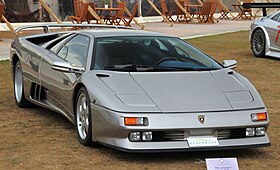
Back لامبورغيني ديابلو Arabic Lamborghini Diablo Breton Lamborghini Diablo BS Lamborghini Diablo Catalan Lamborghini Diablo Czech Lamborghini Diablo German Lamborghini Diablo Spanish Lamborghini Diablo Estonian Lamborghini Diablo Basque لامبورگینی دیابلو Persian
| Lamborghini Diablo | |
|---|---|
 Lamborghini Diablo SE30 | |
| Overview | |
| Manufacturer | Lamborghini |
| Production | 1990–2001[1] |
| Assembly | Italy: Sant'Agata Bolognese |
| Designer |
|
| Body and chassis | |
| Class | Sports car (S) |
| Body style | 2-door coupé 2-door retractable hard-top convertible (roadster) |
| Layout | Longitudinal, Mid-engine, rear-wheel drive / all-wheel drive |
| Doors | Scissor |
| Related | Vector M12 |
| Powertrain | |
| Engine | 5.7–6.0 L Lamborghini V12 |
| Transmission | 5-speed manual |
| Dimensions | |
| Wheelbase | 2,650 mm (104.3 in) |
| Length | 4,460 mm (175.6 in)–4,470 mm (176.0 in) |
| Width | 2,040 mm (80.3 in) |
| Height | 1,105 mm (43.5 in)–1,115 mm (43.9 in) |
| Curb weight |
|
| Chronology | |
| Predecessor | Lamborghini Countach |
| Successor | Lamborghini Murciélago |
The Lamborghini Diablo (meaning "devil" in Spanish), is a series of high-performance V12, rear mid-engined sports cars in the supercar market segment, built by Italian automobile manufacturer Lamborghini from 1990 through 2001. It is the first production Lamborghini with a top speed in excess of 200 mph (322 km/h).
In 1993, the Diablo VT (for 'Viscous Traction') became Lamborghini's first all-wheel drive production sportscar. The car retained its rear-wheel drive character, but a computer-modulated system could direct up to 25% of the engine's torque to the front wheels in case of rear-axle slip, to improve the car's handling. In 1995, Lamborghini also began building their first open-top V12, in the form of a Diablo roadster. During the later years, a number of special editions were built, typically in very small numbers.
After the end of its production run in 2001, the Diablo was replaced by the Lamborghini Murciélago.
- ^ LamboCars.com: Diablo VT 6.0 Special Edition
- ^ "Designer". ajovalo.net. Retrieved 8 February 2012.
- ^ "Archived copy" (PDF). Archived from the original (PDF) on 26 May 2011. Retrieved 1 May 2009.
{{cite web}}: CS1 maint: archived copy as title (link)